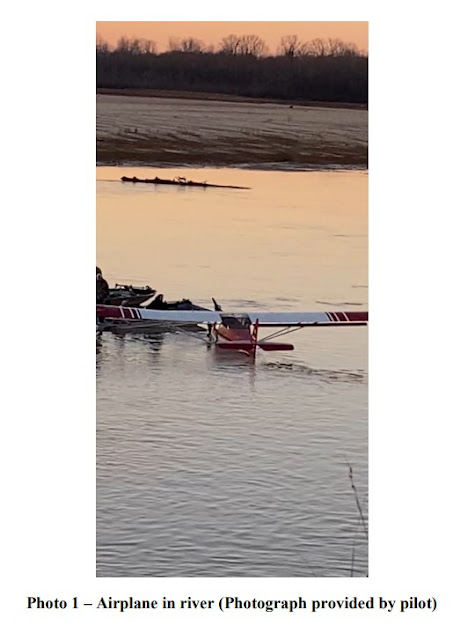
Aviation Accident Final Report - National Transportation Safety Board
The National Transportation Safety Board did not travel to the scene of this accident.
Additional Participating Entity:
Federal Aviation Administration / Flight Standards District Office; Dallas, Texas
Investigation Docket - National Transportation Safety Board:
Location: Woodstock, Texas
Accident Number: CEN22LA133
Date and Time: February 27, 2022, 17:00 Local
Registration: N494KF
Aircraft: Kitfox 4-1200
Aircraft Damage: Substantial
Defining Event: Aerodynamic stall/spin
Injuries: 1 None
Flight Conducted Under: Part 91: General aviation - Personal
Analysis
The pilot departed from a river sand bar, and shortly after takeoff the airplane encountered an unexpected left quartering tailwind. The pilot reported that the airplane’s left wing stalled, which induced a spin at a low altitude. The airplane’s left wing and forward left fuselage impacted the shallow river water and sustained substantial damage. Since the accident, the airplane washed away in the river current and has not been located.
The pilot reported that there were no preaccident mechanical malfunctions or failures with the airplane that would have precluded normal operation.
Probable Cause and Findings
The National Transportation Safety Board determines the probable cause(s) of this accident to be:
The pilot’s failure to maintain proper airspeed and his exceedance of the airplane’s critical angle of attack, which resulted in an aerodynamic stall.
Findings
Environmental issues Tailwind - Effect on operation
Aircraft Airspeed - Not attained/maintained
Aircraft Angle of attack - Capability exceeded
Personnel issues Aircraft control - Pilot
Factual Information
History of Flight
Initial climb Aerodynamic stall/spin (Defining event)
Pilot Information
Certificate: Private
Age: 38, Male
Airplane Rating(s): Single-engine land
Seat Occupied: Left
Other Aircraft Rating(s): None
Restraint Used: 4-point
Instrument Rating(s): None
Second Pilot Present: No
Instructor Rating(s): None
Toxicology Performed:
Medical Certification: Class 3 Without waivers/limitations
Last FAA Medical Exam: February 24, 2020
Occupational Pilot: No
Last Flight Review or Equivalent: June 5, 2020
Flight Time: (Estimated) 451 hours (Total, all aircraft), 13 hours (Total, this make and model), 393 hours (Pilot In Command, all aircraft), 46 hours (Last 90 days, all aircraft), 25 hours (Last 30 days, all aircraft)
Aircraft and Owner/Operator Information
Aircraft Make: Kitfox
Registration: N494KF
Model/Series: 4-1200
Aircraft Category: Airplane
Year of Manufacture: 1994
Amateur Built: Yes
Airworthiness Certificate: Experimental (Special)
Serial Number: 1857
Landing Gear Type: Tailwheel
Seats: 2
Date/Type of Last Inspection: Condition
Certified Max Gross Wt.: 1200 lbs
Time Since Last Inspection:
Engines: 1 Reciprocating
Airframe Total Time: 385 Hrs at time of accident
Engine Manufacturer: Rotax
ELT: Installed, not activated
Engine Model/Series:
Registered Owner:
Rated Power:
Operator: On file
Operating Certificate(s) Held: None
Meteorological Information and Flight Plan
Conditions at Accident Site: Visual (VMC)
Condition of Light: Dusk
Observation Facility, Elevation: KTXK, 361 ft msl
Distance from Accident Site: 23 Nautical Miles
Observation Time: 17:53 Local
Direction from Accident Site: 109°
Lowest Cloud Condition: Clear
Visibility: 10 miles
Lowest Ceiling: None
Visibility (RVR):
Wind Speed/Gusts: 4 knots /
Turbulence Type Forecast/Actual: None / None
Wind Direction: 10°
Turbulence Severity Forecast/Actual: N/A / N/A
Altimeter Setting: 30.31 inches Hg
Temperature/Dew Point: 12°C / -3°C
Precipitation and Obscuration: No Obscuration; No Precipitation
Departure Point: Woodstock, TX
Type of Flight Plan Filed: None
Destination: Atlanta, TX (ATA)
Type of Clearance: None
Departure Time:
Type of Airspace: Class G
Wreckage and Impact Information
Crew Injuries: 1 None
Aircraft Damage: Substantial
Passenger Injuries:
Aircraft Fire: None
Ground Injuries:
Aircraft Explosion: None
Total Injuries: 1 None
Latitude, Longitude: 33.579925,-94.422579 (est)
Preventing Similar Accidents
Prevent Aerodynamic Stalls at Low Altitude
While maneuvering an airplane at low altitude in visual meteorological conditions, many pilots fail to avoid conditions that lead to an aerodynamic stall, recognize the warning signs of a stall onset, and apply appropriate recovery techniques. Many stall accidents result when a pilot is momentarily distracted from the primary task of flying, such as while maneuvering in the airport traffic pattern, during an emergency, or when fixating on ground objects.
An aerodynamic stall can happen at any airspeed, at any altitude, and with any engine power setting. Pilots need to be honest with themselves about their knowledge of stalls and preparedness to recognize and handle a stall situation. Training can help pilots fully understand the stall phenomenon, including angle-of-attack concepts and how weight, center of gravity, turbulence, maneuvering loads and other factors can affect an airplane's stall characteristics. The stall characteristics may be different in each type of plane, so learn them before you fly.
The stall airspeeds marked on the airspeed indicator (for example, the bottom of the green arc and the bottom of the white arc) typically represent steady flight speeds at 1G at the airplane's maximum gross weight in the specified configuration. Maneuvering loads and other factors can increase the airspeed at which the airplane will stall. For example, increasing bank angle can increase stall speed exponentially.
Reducing angle of attack by lowering the airplane's nose at the first indication of a stall is the most important immediate response for stall avoidance and stall recovery. This may seem counterintuitive at low altitudes, but is a necessary first step.
See http://www.ntsb.gov/safety/safety-alerts/documents/SA_019.pdf for additional resources.
The NTSB presents this information to prevent recurrence of similar accidents. Note that this should not be considered guidance from the regulator, nor does this supersede existing FAA Regulations (FARs).



















No comments:
Post a Comment